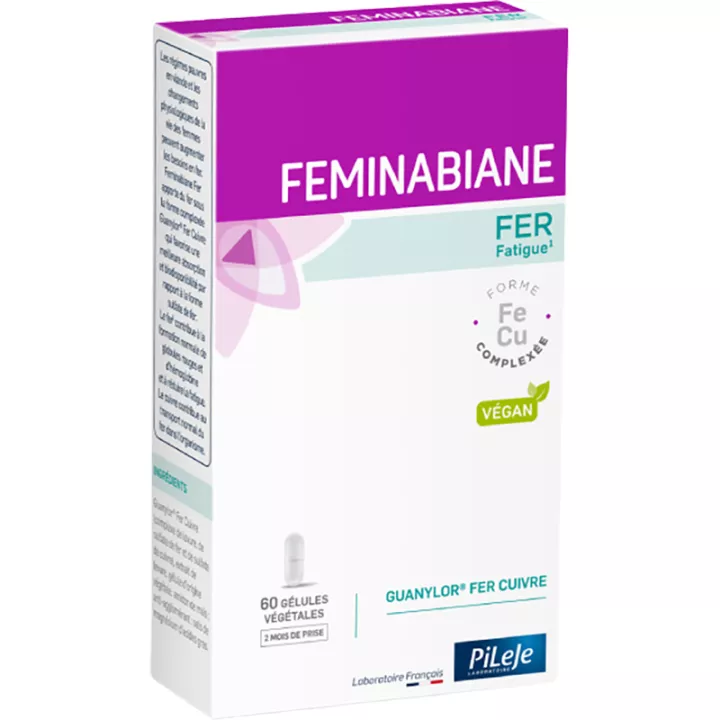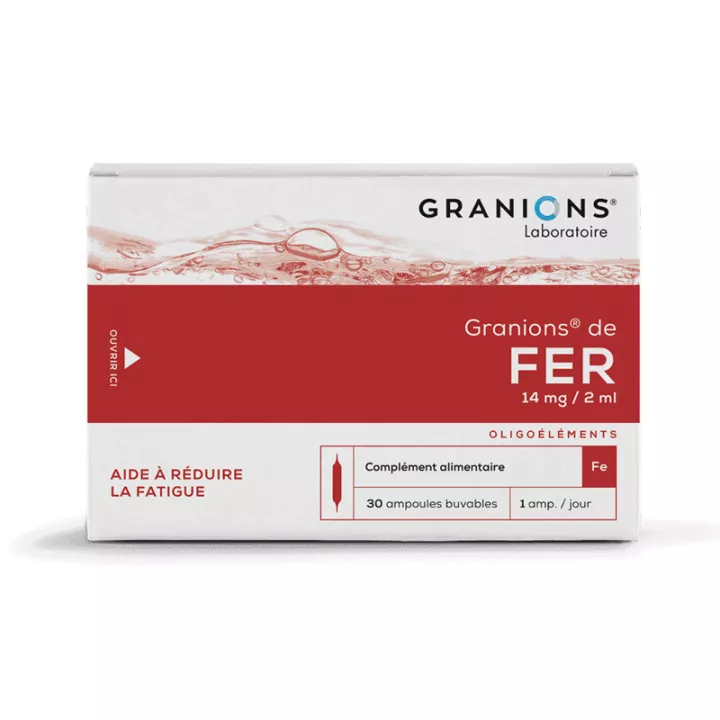What is Feminabiane Fer Pileje used for?
This dietary supplement has been formulated for women who need to supplement their iron intake. Iron is a trace element essential to the transport and storage of oxygen in the body. Iron is a constituent of the hemoglobin found in red blood cells, which carry oxygen from the lungs to the tissues. The adult human body contains around 4 g of iron.
An unbalanced diet, a vegetarian diet or reduced absorption can lead to an iron imbalance. In addition, physiological changes in a woman's life, such as pregnancy or menstruation, can increase iron requirements. Feminabiane Fer provides 14 mg of iron, i.e. 100% of the NRV*, which helps reduce fatigue and contributes to thenormal formation of red blood cells and hemoglobin. It also provides 0.5 mg of copper, which contributes to the normal transport of iron in the body.
Iron is an essential trace element for the body, playing a crucial role in oxygen transport and storage. Its main function lies in its participation in the composition of hemoglobin, a protein found in red blood cells. Hemoglobin is responsible for transporting oxygen from the lungs to the body's various tissues, thus ensuring the oxygen supply necessary for cell function. Iron is also involved in other biological processes, such as energy production and optimal functioning of the immune system. The average adult has around 4 grams of iron in his or her body, underlining its importance for overall health and well-being.
Women have specific iron requirements, not least because of certain periods in their lives such as pregnancy or menstruation. During pregnancy, iron requirements increase considerably to meet the body's increased demand for placental development and fetal growth. Similarly, menstruation can lead to significant iron losses in women of childbearing age, increasing the risk of iron deficiency. In addition, an unbalanced diet or a vegetarian diet can also contribute to iron deficiency in women.
Each capsule of Pileje Feminabiane Fer provides a significant amount of iron, 14 mg, corresponding to 100% of the Reference Nutritional Values (NRV). This optimal dose effectively meets the body's iron requirements, helping to reduce fatigue and maintain normal red blood cell and haemoglobin formation. What's more, this dietary supplement also contains 0.5 mg copper, an essential trace element involved in the normal transport of iron in the body. This combination of iron and copper guarantees optimal absorption of iron in the body, ensuring maximum effectiveness of the product.
Feminabiane Fer therefore offers a practical and effective solution to help women maintain an optimal nutritional balance and prevent iron deficiency, particularly at times of life when iron requirements are increased.
We also offer Iron Filmtech Orodispersible x30, at the best price in our online pharmacy.
How do I take this Iron Supplement to Reduce Fatigue?
1 capsule a day, preferably with meals. Avoid taking with tea for 60 days.
Give your opinion on the advice for use and dosage of Feminabiane FER Pileje 60 gélules with our partner Verified opinions after your purchase.
Precautions for use
- Do not exceed the recommended daily dose.
- This dietary supplement is not a substitute for a varied, balanced diet and a healthy lifestyle.
- Keep out of reach of children.
- Best consumed before the end of the shelf life and batch number indicated on the underside of the box.
What is the composition of these capsules to Bring Iron?
Ingredients
Guanylor® Fer Cuivre (complex of yeast, iron sulfate and copper sulfate), yeast extract, vegetarian capsule, bulking agent: corn starch, anti-caking agent: magnesium salts of fatty acids.
| Average analysis |
Per capsule |
% NRV* |
| Iron (mg) |
14 |
100 |
| Copper (mg) |
0.50 |
50 |
*NRV: Reference Nutritional Value
Presentation
Box of 60 capsules, available at the best online price.
Expert advice
Iron deficiency is the most common nutritional deficiency in the world. It particularly affects women. Iron is one of the minerals essential to the human body. It is found in all cell types. The body cannot synthesize iron, so it must obtain it from food.












